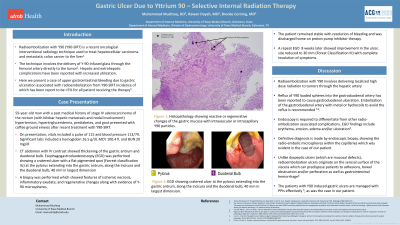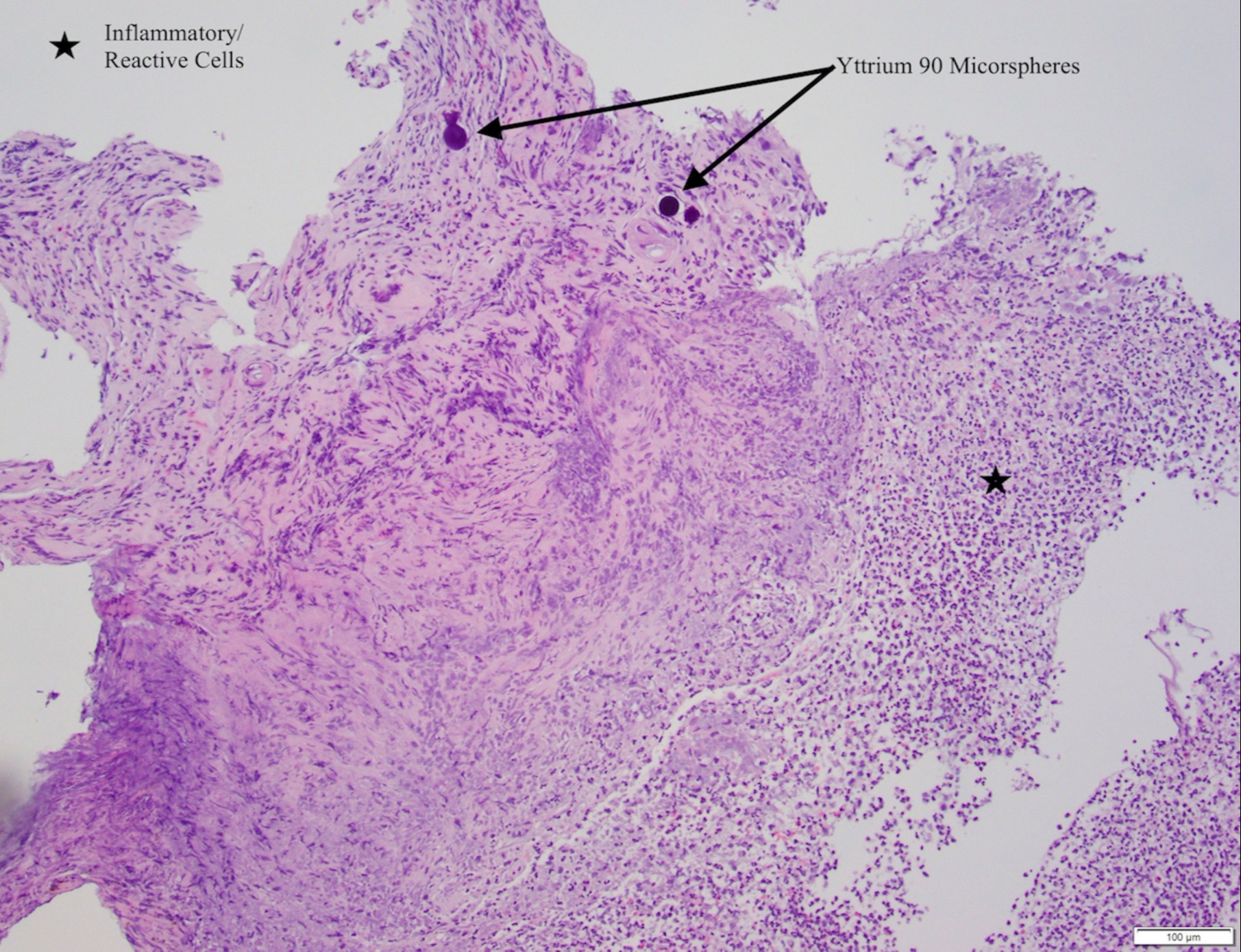Sunday Poster Session
Category: GI Bleeding
P0614 - Gastric Ulcer Due to Yttrium-90 Selective Internal Radiation Therapy
Sunday, October 22, 2023
3:30 PM - 7:00 PM PT
Location: Exhibit Hall

Has Audio

Muhammad Mushtaq, DO
University of Texas Medical Branch-Galveston
Galveston, TX
Presenting Author(s)
Muhammad Mushtaq, DO1, Rawan Dayah, MD2, Brooke Corning, MD3
1University of Texas Medical Branch-Galveston, Galveston, TX; 2UTMB, Webster, TX; 3University of Texas Medical Branch, Galveston, TX
Introduction: Yttrium-90 selective internal radiation therapy (Y90- SIRT) is a recent oncological interventional radiology technique used to treat hepatocellular carcinoma and metastatic colon cancer to the liver. With increasing use, hepatic and extrahepatic complications are reported. We present a case of gastric ulceration associated with Y90-SIRT to bring awareness to utilization of Y90-SIRT in the current clinical practice and potential complications related to the therapy which should be considered in the targeted population.
Case Description/Methods: Our patient with history of stage IV adenocarcinoma of the rectum (with hepatic metastasis) s/p recent Y90-SIRT presented with coffee ground emesis. Esophagogastroduodenoscopy showed a cratered ulcer with a flat pigmented spot at the pylorus, 40 mm in largest dimension. Biopsy showed features of ischemic necrosis, inflammatory exudate, and regenerative changes with evidence of Y-90 microspheres. Patient was initiated on PPI with clinical improvement and discharged. A repeat EGD 8 weeks later showed improvement in the ulcer size.
Discussion: Y90-SIRT involves delivery of Y-90-infused microspheres to tumor through hepatic artery with the intention of sparing liver parenchyma given preferential portal venous blood supply of non-tumor parenchyma. Initially introduced as a locoregional embolization therapy in the context of PVT where use of TACE was contraindicated, currently, Y90 is being used for tumor control as a bridge to transplant or resection, downstaging of tumors for curative treatment as well as a curative therapy when used for segmentectomy. With increased utilization, hepatic and extra-hepatic complications are reported including radioembolization induced liver disease (20%), GI complications (0-13%), radiation pneumonitis (< 1%), radiation dermatitis, lymphopenia. Gastric ulcers are reported in less than 5% of the cases. Unlike dyspeptic ulcers, radioembolization ulcers originate on the serosal surface of the viscera and can lead to adhesions, gastrointestinal hemorrhage, bowel obstruction and/or perforation. The patients with Y90 induced gastric ulcers are managed with PPIs effectively. These patients may benefit from prophylactic proton pump inhibitor therapy after radiation therapy which may reduce the incidence of gastric ulceration, a potential area of future study.

Disclosures:
Muhammad Mushtaq, DO1, Rawan Dayah, MD2, Brooke Corning, MD3. P0614 - Gastric Ulcer Due to Yttrium-90 Selective Internal Radiation Therapy, ACG 2023 Annual Scientific Meeting Abstracts. Vancouver, BC, Canada: American College of Gastroenterology.
1University of Texas Medical Branch-Galveston, Galveston, TX; 2UTMB, Webster, TX; 3University of Texas Medical Branch, Galveston, TX
Introduction: Yttrium-90 selective internal radiation therapy (Y90- SIRT) is a recent oncological interventional radiology technique used to treat hepatocellular carcinoma and metastatic colon cancer to the liver. With increasing use, hepatic and extrahepatic complications are reported. We present a case of gastric ulceration associated with Y90-SIRT to bring awareness to utilization of Y90-SIRT in the current clinical practice and potential complications related to the therapy which should be considered in the targeted population.
Case Description/Methods: Our patient with history of stage IV adenocarcinoma of the rectum (with hepatic metastasis) s/p recent Y90-SIRT presented with coffee ground emesis. Esophagogastroduodenoscopy showed a cratered ulcer with a flat pigmented spot at the pylorus, 40 mm in largest dimension. Biopsy showed features of ischemic necrosis, inflammatory exudate, and regenerative changes with evidence of Y-90 microspheres. Patient was initiated on PPI with clinical improvement and discharged. A repeat EGD 8 weeks later showed improvement in the ulcer size.
Discussion: Y90-SIRT involves delivery of Y-90-infused microspheres to tumor through hepatic artery with the intention of sparing liver parenchyma given preferential portal venous blood supply of non-tumor parenchyma. Initially introduced as a locoregional embolization therapy in the context of PVT where use of TACE was contraindicated, currently, Y90 is being used for tumor control as a bridge to transplant or resection, downstaging of tumors for curative treatment as well as a curative therapy when used for segmentectomy. With increased utilization, hepatic and extra-hepatic complications are reported including radioembolization induced liver disease (20%), GI complications (0-13%), radiation pneumonitis (< 1%), radiation dermatitis, lymphopenia. Gastric ulcers are reported in less than 5% of the cases. Unlike dyspeptic ulcers, radioembolization ulcers originate on the serosal surface of the viscera and can lead to adhesions, gastrointestinal hemorrhage, bowel obstruction and/or perforation. The patients with Y90 induced gastric ulcers are managed with PPIs effectively. These patients may benefit from prophylactic proton pump inhibitor therapy after radiation therapy which may reduce the incidence of gastric ulceration, a potential area of future study.

Figure: Histopathology showing reactive or regenerative changes of the gastric mucosa with intravascular or intracapillary Y90 particles.
Disclosures:
Muhammad Mushtaq indicated no relevant financial relationships.
Rawan Dayah indicated no relevant financial relationships.
Brooke Corning indicated no relevant financial relationships.
Muhammad Mushtaq, DO1, Rawan Dayah, MD2, Brooke Corning, MD3. P0614 - Gastric Ulcer Due to Yttrium-90 Selective Internal Radiation Therapy, ACG 2023 Annual Scientific Meeting Abstracts. Vancouver, BC, Canada: American College of Gastroenterology.
